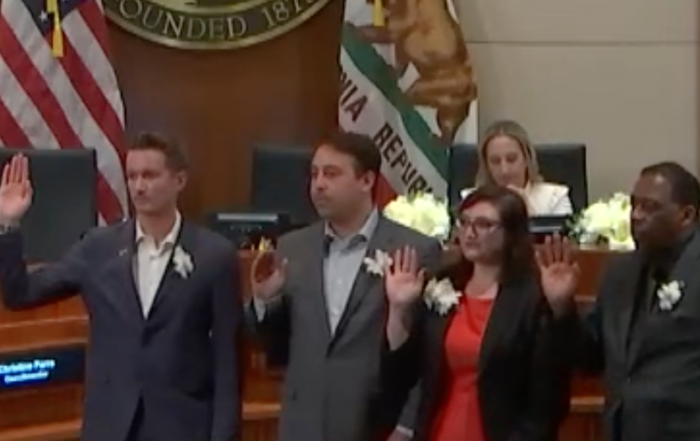Public safety and issues surrounding equity in policing were the sole focus on Monday evening as the West Hollywood City Council and its Public Safety Commission met in a joint session.
One of two major agenda items was the receipt and discussion of a report from the Center for Policing Equity (CPE) that assessed the racial disparities in interactions residents of West Hollywood have experienced with the West Hollywood Sheriff’s Station deputies.
Sean Eldridge, Director of Law Enforcement Initiatives for CPE was on hand to present his organization’s findings. He was joined by colleagues Matthew Graham, a Senior Data Analyst, and Cierren Edmondson, CPE’s Community Engagement Coordinator.
“We believe that identifying and dismantling the inequities faced by Black and Brown communities is an essential first step in reducing harm and reimagining public safety systems for all communities,” said Eldridge. “Our goal is to create greater equity in public safety systems.” He added that much of CPE’s work was done in cooperative collaboration with the L.A. Sheriff’s Department (LASD).
Eldridge was complimentary of several steps the LASD West Hollywood Station has implemented, including:
- Implementing new training programs and updating its policies on data collection and racial profiling
- Engaging in a variety of community outreach initiatives and partnerships with social services providers
- Employing co-response teams and implementing several diversion strategies to address events facing those experiencing a mental health crisis, homelessness, or substance abuse issues
Graham, who explained the methodology of the study, said the public is going to see major disparities, but said the LASD shouldn’t be condemned for them; rather, he feels they deserve credit for entering into the partnership with CPE to confront the issue.
The findings themselves were indeed telling. Numbers on the use of force, for example, between 2017-2021, broke down thusly:
- 28 percent of use of force incidents were against Black persons who make up 3.6 percent of the West Hollywood population
- 22 percent were against Latinx persons who make up 11 percent of the population
- 46 percent were against White persons who make up 76 percent of the population
- The numbers do not account for non-residents who may have been subject to the use of force while in town for work or entertainment purposes
With regard to traffic stops between July 1, 2021-December 31, 2021:
- 18 percent were Black
- 20 percent were Latinx
- 71 percent were White
- 4 percent were Asian
- 4 percent were Other
Once actually stopped, Black drivers are searched five times as often as White drivers, despite the fact that searches of Black and White drivers yielded an equal amount of contraband. And Latinx drivers were searched three times as often as Whites, despite the fact that they often possessed less contraband than White drivers.
In addition, both Black and Latinx drivers were arrested more frequently than White drivers. Stops made of pedestrians were closer in line to the use of force percentages against each ethnic group.
Eldridge assured the council that CPE isn’t just leaving the statistics behind and heading home. He said they were committed to now jumping into “data-driven solutions to racial disparities” and employing what he called “harm reduction products,” which includes community input and engagement beyond just the data.
Councilmember John Heilman questioned a part of the methodology speaking to traffic stops, saying the traffic stop shouldn’t be considered successful simply if there is contraband found, but rather it should be considered successful if it had a lawful, legitimate predicate like probable cause.
“How would we be able to dig into that and determine whether some of these disparities are the result of either behavior or actions that lead police to a constitutional standard for stopping people?” asked Heilman.
Graham admitted they would “need to take a deeper dive on that” to find out specific reasons that escalated to full traffic stops.
Mayor Pro Tem John Erickson asked Director of Public Safety Danny Rivas how many LASD deputies were assigned to West Hollywood Station between 2018-2021. City Manager David Wilson jumped in with the numbers saying it was 63, 62, 63, and down to 60 during the peak of COVID. Erickson wondered given the low turnover and high job satisfaction reported from deputies in West Hollywood, if the city and CPE could study whether it was the same deputies often making these stops and arrests.
Mayor Sepi Shyne asked Eldridge and his team if, in future analysis, they could return and compare the statistics before the council’s action to de-emphasize certain reasons for traffic stops versus after the policy has been in place for some time. Eldridge acknowledged that can and probably should be done, but that changes in the numbers wouldn’t reflect other reasons the numbers may have gone up or down.
The public also weighed in. Resident Mikie Friedman argued she and other members of the disability community are also being profiled in a way. She says crimes against them are largely being ignored, citing for example illegal scooter riders hitting them while riding on sidewalks.
High-profile activist and Commissioner Jackie Steele asked, “I’m unclear of the questions of resident versus non-resident,” she began, “I don’t care how or why our Black community members or queer Black siblings get here or what their business is in the city. I simply want them to have a safe, enjoyable, and equitable experience.” She then differentiated traffic stops for Black, Indigenous, and People of Color (BIPOC), saying that their stops often come with the added insult of an officer’s hand on their gun when making the stop.
Commissioner and recent city council candidate Zekiah Wright, who is Black, said that they were one such party approached by police officers with hands on their guns.
Public Safety Commissioner Chair Tod E. Hallman asked whether a blind survey of sheriff’s deputies has been conducted asking why they make certain stops when they do. CPE says it has not had a chance to conduct one in West Hollywood. Commissioner Adam Eramian asked how many non-traffic related stops were made of unhoused persons, to which CPE said they hadn’t measured but could include the category in the future.
In conclusion, Councilmember Chelsea Byers stated, “I don’t want any of us to look at this and say we’re doing enough, but instead say we’re on a meaningful path as a community that we should celebrate and recognize.”
Erickson said, “This report is something that should present all of us to examine our own privileges – our own White privilege, or whatever privilege that we have – but it is something I think we should use as a battle cry for how the city can lead the way for equity and justice for all, whether you live here or not.”
Stay informed. Sign up for The Westside Voice Newsletter
By clicking submit, you agree to share your email address with Westside Voice. We do not sell or share your information with anyone.








